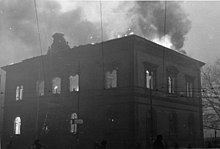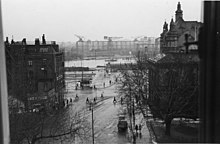Thaulow Museum
The Thaulow Museum in Kiel was a collector's museum from 1878 to 1920 and then the first Schleswig-Holstein State Museum until 1944 .
Face of the building





The museum building was built from 1875 to 1878 on behalf of the Province of Schleswig-Holstein. The plot of land made available free of charge by the city of Kiel was located in the suburbs on the site of the filled brick pond that was created during the construction of the Nikolaikirche . Nowadays this is the area at the intersection of Ziegelteich, Sophienblatt, Stresemannplatz, Holstenplatz, Andreas-Gayk-Straße.
The Kiel architect Heinrich Moldenschardt , a student of Gottfried Semper , designed the two-story villa as a historicizing brick building with stylistic elements of the Italian Renaissance in a terracotta structure. This old building of the museum was hit by fire bombs on January 5, 1944 and destroyed. The ruins were torn down in May 1948.
The extension built in 1911, which offered four times the exhibition space as the old building, remained under other use until 1970, when it was demolished in favor of a new department store on the corner of Sophienblatt and Ziegelteich.
History of the museum

The initiator and at the same time namesake of the museum was the art collector Gustav Ferdinand Thaulow , professor of philosophy and education at the University of Kiel . In 1875 he offered his collection to the Provincial Government of Schleswig-Holstein as a donation if it was to move it to a new museum building. The government agreed on November 3, 1875. The museum was opened on August 10, 1878. At the opening, the exhibition area of 700 m² was hardly enough to accommodate the extensive, but not inventoried collection of the founder Gustav Ferdinand Thaulow. There was also a lack of professional management and a curator , so that the collection fell into disrepair.
From 1893 to 1904, the art historian Adelbert Matthaei (1859–1924) carried out an intensive reorganization of the Thaulow Museum. Matthaei - professor of art history at the University of Kiel - found support from Count Kurt von Reventlou zu Damp , the chairman of the Schleswig-Holstein Provincial Parliament . From 1898, Matthaei assisted Jürgen Haupt (1870–1958) as museum director for the reorganization measures. However, Haupt resigned from his office in 1900 when a planned extension failed. Matthaei played a major role in the purchase of the Landkirchen Retable , a late Gothic altarpiece from the vicinity of Bertram von Minden .
In the spring of 1901 Gustav Brandt (1865–1919) took over the management. In negotiations lasting several years, Brandt was finally able to build the extension with funding from the city of Kiel and the provincial council. The new building, which increased four times the original exhibition area, was inaugurated on June 14, 1911.
After the end of the First World War , the Treaty of Versailles (1919) and the changed course of the border between Germany and Denmark through the referendum of 1920 brought about a new situation in the province of Schleswig-Holstein. Ernst Sauermann (1880–1956) from Flensburg , who became museum director in 1920, reacted to this . From the locally oriented museum, he developed the concept for a state museum that was supposed to emphasize popular education in Schleswig-Holstein. After the beginning of the Second World War , Sauermann had the inventory moved to Ostholstein in 1940. The museum did not reopen in Kiel. From 1948 onwards, his collections, which were outsourced during the war, were moved to Gottorf Castle in Schleswig . As the successor to the former Thaulow Museum, the newly established State Museum for Art and Cultural History was opened there in 1950 .
Conceptions
Following the will of the founder Gustav Ferdinand Thaulow and the resolutions of the Schleswig-Holstein Provincial Parliament, the initial conception of the museum was aimed in three directions:
- Presentation of Schleswig-Holstein's cultural history
- Preservation of art and crafts products
- Art history teaching collection for the University of Kiel .
In the further development of the museum, the promotion of the arts and crafts direction came to the fore, so that the name Thaulow Museum was given a special programmatic addition by the name of the arts and crafts museum of the province of Schleswig-Holstein . This determination resulted in an arrangement of the collections according to style periods ( Period Rooms ) for the expanded museum .
literature
- Gustav Thaulow: The Kiel Art Museum. A signpost through the same; at the same time a short introduction to the study of art. Kiel 1853.
- Partial print: Gustav Thaulow: Kiel gets an art museum. In: Christa Geckeler (Ed.): Memories of Kiel in the Danish time 1773/1864. Husum Druck- und Verlagsgesellschaft, Husum 2012 ISBN 978-3-89876-618-0 , pp. 33-35.
- Adelbert Matthaei: To the knowledge of the medieval carved altars of Schleswig-Holstein. With a directory of the wood sculpture works from the period up to 1530 in the Thaulow Museum in Kiel (= contributions to the history of art in Schleswig-Holstein 1). EA Seemann, Leipzig 1898.
- Gustav Brandt: Guide through the collections of the Thaulow Museum in Kiel, the arts and crafts museum of the Schleswig-Holstein province. Handorff, Kiel 1911.
- Hans-Günther Andresen: From the Italian villa to the Wilhelmine metropolitan company. For the new building planning and architecture of the expanded Thaulow Museum in Kiel . In: Nordelbingen 79, 2010, pp. 165–212.
- Jan Drees: The Thaulow Museum 100 years ago. The applied arts museum of the province Schleswig-Holstein on the way to the Schleswig-Holsteinisches Landesmuseum - the Kieler Thaulow-Museum in its exemplary establishment by Gustav Brandt (1901-1919) and its later addition by Ernst Sauermann (1920-1947). Contributions to the history of the house and its collections (= special publication by the Society for Kiel City History , Volume 66). Schleswig-Holstein State Museums Foundation Gottorf Castle, Schleswig 2011, ISBN 978-3-00-034404-6 .
- Carsten Fleischhauer: The Thaulow Museum in the time of National Socialism. In: Sandra Scherreiks, Doris Tillmann (Ed.): The world in collections. 50 years of Kiel City Museum, 350 years of collection and museum history. Ludwig, Kiel 2015, ISBN 978-3-86935-244-2 , pp. 76-87.
Web links
- Thaulow Museum - the first state museum on the Schleswig-Holstein side from A – Z of the Society for Schleswig-Holstein History
- May 27, 1948: The ruins of the Thaulow Museum are torn down on the site of the Kiel City Archives
Individual evidence
- ^ Hartwig Beseler, Niels Gutschow: Kriegsschicksale Deutscher Architektur . Volume I: North. Wachholtz, Neumünster 1988, page 9
- ^ A b Gustav Brandt: Guide through the collections of the Thaulow Museum in Kiel, the applied arts museum of the Schleswig-Holstein province. Handorff, Kiel 1911, foreword, pp. I – II.
- ^ A b Gustav Brandt: Guide through the collections of the Thaulow Museum in Kiel, the applied arts museum of the Schleswig-Holstein province. Handorff, Kiel 1911, Introduction, pp. III – IV.









